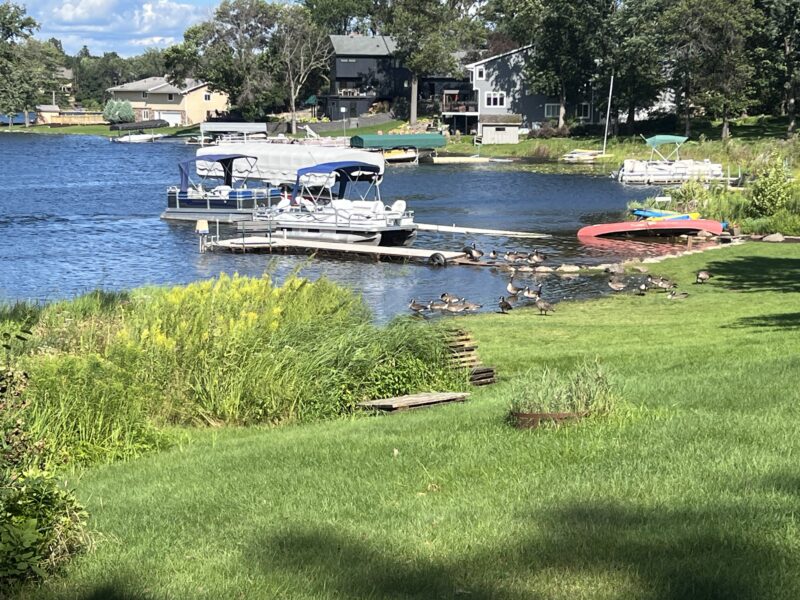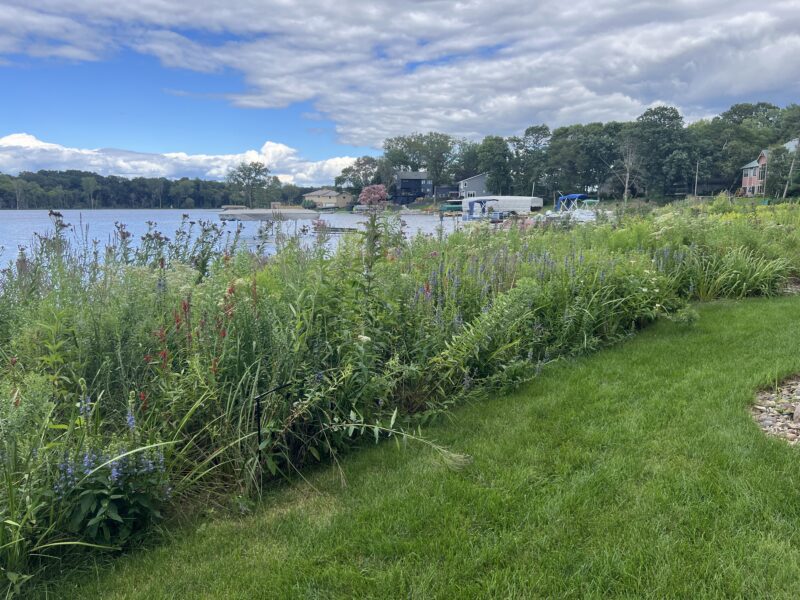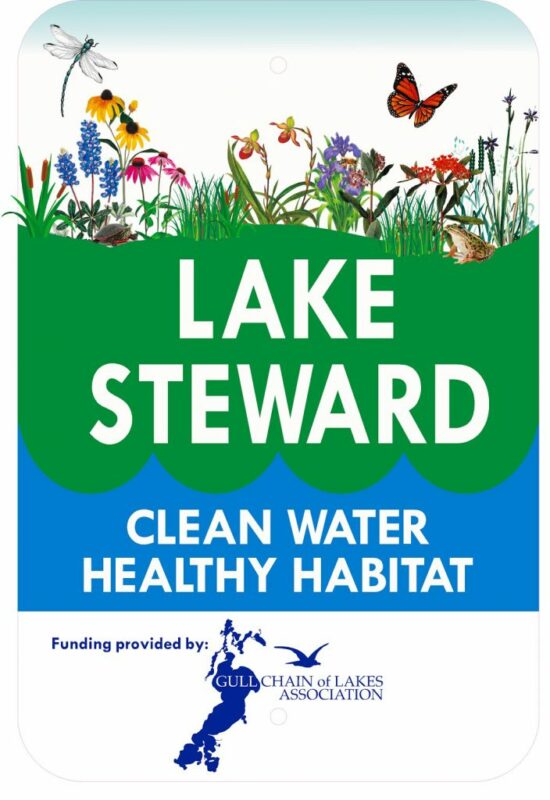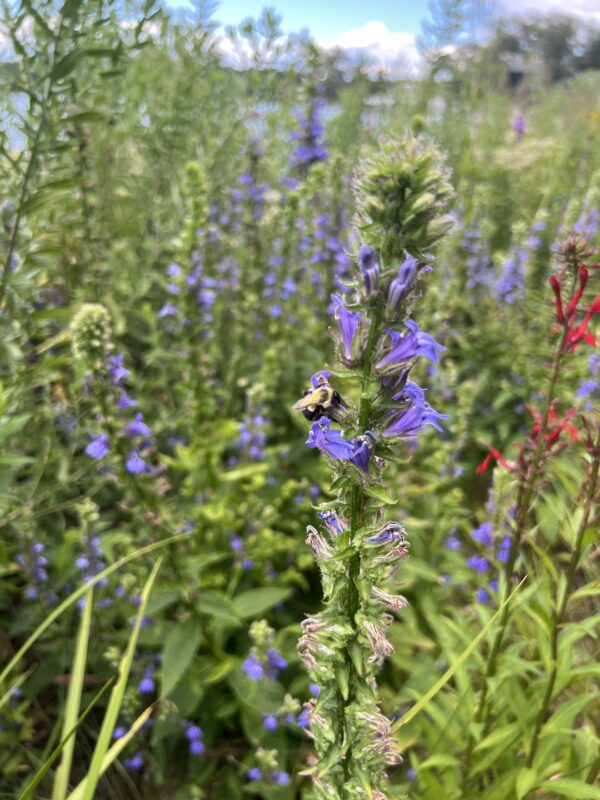
Peer across Snail Lake in Shoreview, and you’ll quickly see how different the shoreline can look even on the same body of water. The suburban lake is bordered by a regional park at one end and a large wetland at the other, with homes sandwiched in between. Boats, kayaks and other recreational gear adorn the lake’s edge.
At many of the homes, docks slump in the high water, partially submerged after a summer of higher-than-average rains. One leads straight to a mowed lawn, with water flooding past a row of neatly-packed rocks. A gaggle of geese — almost twenty — mill about, some foraging, others keeping watch.
The neighboring property is a different scene. The high waters are buffered by beds of tall wildflowers and grasses that wave in the afternoon wind. Busy bumble bees buzz among beds of blue lobelia, and a hummingbird darts between stands of bright red cardinal flower. The deep-rooted native plants that make up this resilient shoreline help hold soil in place and slow runoff on its way to the lake, preventing erosion and protecting Snail Lake’s water quality all while keeping the geese at bay.

In Minnesota, natural shorelines are getting harder to find. About half of the state’s natural shorelines are lost, and they continue to disappear at an alarming rate of 1 to 2 percent per decade, according to the Minnesota Department of Natural Resources (MN DNR). When native plants get replaced by development — roads, buildings, turfgrass — pollutants flow quickly over these surfaces and into our lakes and rivers. The resulting negative impacts to water quality affect not just wildlife and the environment, but recreation, property values, and human health and well-being.
Riprap, for example, has become a common solution contractors and property owners use to address erosion issues on theirshoreline. While riprap stones may look tidy, they can make problems worse by increasing the speed of water runoff into a lake and offering no benefits to wildlife. “Lakescaping” with deep-rooted native plants is a more effective erosion control solution and provides privacy, beauty, and habitat for beneficial wildlife like pollinators, dragonflies, frogs, and fish.

Minnesota’s degrading natural shorelines are not going unnoticed. Two years ago, concerned government and nonprofit conservation professionals formed the Minnesota Natural Shoreline Partnership with a goal of moving towards a future where Minnesota lakeshores have 75% natural vegetation at least 25 feet deep. And this summer, MPR News ran a series called “Trouble by the Water,” which explores the cultural shifts that led to suburban-style development on Minnesota’s lakeshores and how advocates are working to change social norms to embrace more resilient shores.
A Team Effort
Who is responsible for protecting Minnesota’s shorelines? In short, all of us. Through the Shoreland Management Act, the MN DNR sets shoreland regulations and shoreland development standards for local governments to implement. But it is community-led efforts coming from lake associations and individuals that make a neighbor-to-neighbor, on-the-ground impact. We talked with Sami Selter, MN Natural Shoreline Partnership member and Associate Executive Director of the nonprofit Minnesota Lakes and Rivers Advocates (MLR) about the resources her organization provides to help lake associations connect with their residents and build shoreline health, one property at a time.
 “By deciding to join a lake association, you’re saying that you care about the water,” says Selter. “You’re making an impact by doing water quality monitoring or monitoring for AIS (aquatic invasive species) and providing that information to the general community. You become a source of trustworthy information, which is also very locally sourced because it’s about your specific lake.”
“By deciding to join a lake association, you’re saying that you care about the water,” says Selter. “You’re making an impact by doing water quality monitoring or monitoring for AIS (aquatic invasive species) and providing that information to the general community. You become a source of trustworthy information, which is also very locally sourced because it’s about your specific lake.”
Through their Lake Steward Program, MLR trains local volunteers from lake associations to be shoreline evaluators in their community. Volunteers assess their neighbor’s shorelines and give them a plan if work needs to be done. MLR provides planning guidance and connections to local resources.
“When your shoreline reaches a good enough score, we supply you with a Lake Steward sign that people will put on their dock or road,” says Selter. “Connections between a local and another local has been impactful and helps build community — it’s all about encouraging smaller steps and breaking down the process of shoreline restoration in a comprehensive and understandable way.”
Local, one-on-one interactions also help people connect over similar values when it comes to lake health. “Personally, I am a huge turtle fan,” says Selter. “And generally, wildlife is a huge pull for people. That’s why we love to live on the lake. We can see our loons, butterflies, all those creatures. Each person has that one thing that they’re really passionate about. Loons are a big one for Minnesotans, and loons need natural shorelines to nest.”
Where to Start

If you’re ready to make changes on your shoreline and not sure where to begin, Selter recommends starting with a site assessment. Blue Thumb’s Resilient Shorelines Planning Workbook has an easy-to-use site assessment guide to help you understand the health of your shoreline, what can be improved, and what to do next.
“Maybe you realize you could plant some extra trees,” says Selter. “Maybe you don’t mow for a year and get to see the benefits from that. Focus on the smaller steps rather than the larger. If everybody on your lake is doing the small steps, you’re making a huge contribution.”
You also don’t need to do this work alone! Selter recommends connecting with your local county or watershed district to see what support they have available for shoreline restorations projects. Blue Thumb’s workshops and online learning series are great ways to learn about different shoreline restoration options, make a plan, and network with others embarking on similar projects. And if you’re ready to make a bigger impact, consider joining a volunteer stewardship program like Minnesota Lakes and Rivers’ Lake Steward Program or Freshwater Society’s Minnesota Water Stewards program.
“We have this phrase we use in our shoreline partnership, it’s ‘shore’ important,” Selter says. It can be overwhelming to be hit with the negative facts, she explains, but it’s important to stay positive and focus on the actions that you have the ability to take.
Slowly but surely, we can build back our state’s natural shorelines and protect the waters that we love.
– Megan Reich, Metro Blooms Communications and Program Manager
Related Resources
Learn more about Minnesota Lakes and Rivers’ Lake Steward Program and take the “Are You a Lake Steward Quiz” to assess your impact on Minnesota’s lakes from your own backyard.
Blue Thumb’s Resilient Shorelines Planning Workbook is designed to help you plan and complete a shoreline planting project, connecting you with agencies and resources you’ll need along the way. Or, explore Blue Thumb’s Shoreline Stabilization page and connect with a Blue Thumb partner to help you with your project.
Northern Waters Land Trust, a Blue Thumb Partner, supports landowners in establishing conservation easements or land transfers to permanently steward critical shoreland habitat. Check out their website for resources for landowners.
Use the Minnesota Department of Natural Resource’s Restore Your Shore Tool for implementing your own project, check the status of your lake with their Lake Finder tool, and browse their list of best management practices to remediate shore erosion.
The Minnesota Natural Shoreline Partnership’s Minnesota’s Vanishing Natural Shorelines report covers threats faced by natural shorelines and suggested actions for people and organizations to protect and restore shorelines.
